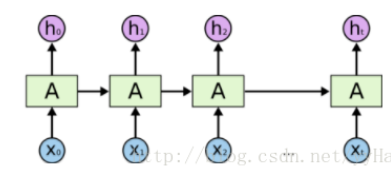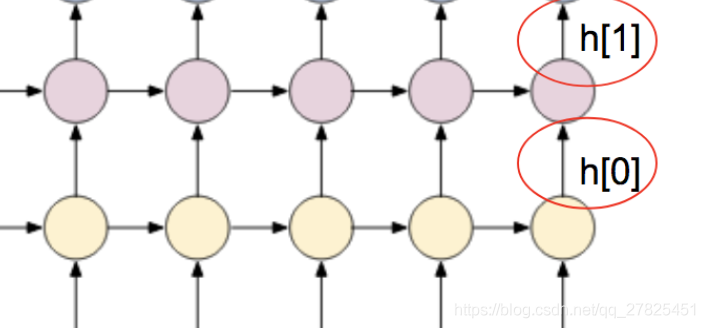- ubuntu12.04环境下使用kvm ioctl接口实现最简单的虚拟机
- Ubuntu 通过无线网络安装Ubuntu Server启动系统后连接无线网络的方法
- 在Ubuntu上搭建网桥的方法
- ubuntu 虚拟机上网方式及相关配置详解
CFSDN坚持开源创造价值,我们致力于搭建一个资源共享平台,让每一个IT人在这里找到属于你的精彩世界.
这篇CFSDN的博客文章pytorch lstm gru rnn 得到每个state输出的操作由作者收集整理,如果你对这篇文章有兴趣,记得点赞哟.
|
1
2
3
4
5
6
7
8
9
10
11
12
13
14
15
16
17
18
19
20
21
22
23
24
|
# coding=UTF-8
import
torch
import
torch.autograd as autograd
# torch中自动计算梯度模块
import
torch.nn as nn
# 神经网络模块
torch.manual_seed(
1
)
# lstm单元输入和输出维度都是3
lstm
=
nn.LSTM(input_size
=
3
, hidden_size
=
3
)
# 生成一个长度为5,每一个元素为1*3的序列作为输入,这里的数字3对应于上句中第一个3
inputs
=
[autograd.Variable(torch.randn((
1
,
3
)))
for
_
in
range
(
5
)]
# 设置隐藏层维度,初始化隐藏层的数据
hidden
=
(autograd.Variable(torch.randn(
1
,
1
,
3
)),
autograd.Variable(torch.randn((
1
,
1
,
3
))))
for
i
in
inputs:
out, hidden
=
lstm(i.view(
1
,
1
,
-
1
), hidden)
print
(out.size())
print
(hidden[
0
].size())
print
(
"--------"
)
print
(
"-----------------------------------------------"
)
# 下面是一次输入多个step的样子
inputs_stack
=
torch.stack(inputs)
out,hidden
=
lstm(inputs_stack,hidden)
print
(out.size())
print
(hidden[
0
].size())
|
print结果:
(1L, 1L, 3L) (1L, 1L, 3L) -------- (1L, 1L, 3L) (1L, 1L, 3L) -------- (1L, 1L, 3L) (1L, 1L, 3L) -------- (1L, 1L, 3L) (1L, 1L, 3L) -------- (1L, 1L, 3L) (1L, 1L, 3L) -------- ---------------------------------------------- (5L, 1L, 3L) (1L, 1L, 3L) 。
可见LSTM的定义都是不用变的,根据input的step数目,一次输入多少step,就一次输出多少output,但只输出最后一个state 。
补充:pytorch中实现循环神经网络的基本单元RNN、LSTM、GRU的输入、输出、参数详细理解 。
前言:这篇文章是对已经较为深入理解了RNN、LSTM、GRU的数学原理以及运算过程的人而言的,如果不理解它的基本思想和过程,可能理解起来不是很简单.
这是官网上面的一个例子,本次以LSTM作为例子而言,实际上,GRU、LSTM、RNN的运算过程是很类似的.
|
1
2
3
4
5
6
7
8
9
10
11
12
13
14
15
16
17
18
19
20
21
22
23
|
import
torch
import
torch.nn as nn
lstm
=
nn.LSTM(
10
,
20
,
2
)
# 序列长度seq_len=5, batch_size=3, 数据向量维数=10
input
=
torch.randn(
5
,
3
,
10
)
# 初始化的隐藏元和记忆元,通常它们的维度是一样的
# 2个LSTM层,batch_size=3,隐藏元维度20
h0
=
torch.randn(
2
,
3
,
20
)
c0
=
torch.randn(
2
,
3
,
20
)
# 这里有2层lstm,output是最后一层lstm的每个词向量对应隐藏层的输出,其与层数无关,只与序列长度相关
# hn,cn是所有层最后一个隐藏元和记忆元的输出
output, (hn, cn)
=
lstm(
input
, (h0, c0))
print
(output.size(),hn.size(),cn.size())
# 分别是:
# torch.Size([5, 3, 20])
# torch.Size([2, 3, 20])
# torch.Size([2, 3, 20]))
|
后面我会详细解释上面的运算过程,我们先看一下LSTM的定义,它是一个类 。
|
1
2
3
4
5
6
7
8
9
10
11
12
13
14
15
16
17
18
19
20
21
22
23
24
25
26
27
28
29
30
31
32
33
34
35
36
37
38
39
40
41
42
43
44
45
46
47
48
49
50
51
52
53
54
55
56
|
class
LSTM(RNNBase):
'''参数Args:
input_size: 输入数据的特征维度,比如我对时间序列建模,特征为1,我对一个句子建模,每一个单词的嵌入向量为10,则它为10
hidden_size: 即循环神经网络中隐藏节点的个数,这个是自己定义的,多少都可以,后面会详说
num_layers: 堆叠的LSTM的层数,默认是一层,也可以自己定义 Default: 1
bias: LSTM层是否使用偏置矩阵 偏置权值为 `b_ih` and `b_hh`.
Default: ``True``(默认是使用的)
batch_first: 如果设置 ``True``, then the input and output tensors are provided
as (batch, seq, feature). Default: ``False``,(seq,batch,features)
dropout: 是否使用dropout机制,默认是0,表示不使用dropout,如果提供一个非0的数字,则表示在每一个LSTM层之后默认使用dropout,但是最后一个层的LSTM层不使用dropout。
bidirectional: 是否是双向RNN,默认是否,If ``True``, becomes a bidirectional LSTM. Default: ``False``
#---------------------------------------------------------------------------------------
类的构造函数的输入为Inputs: input, (h_0, c_0)
- **input** of shape `(seq_len, batch, input_size)`: tensor containing the features of the input sequence.
- **h_0** of shape `(num_layers * num_directions, batch, hidden_size)`: tensor
containing the initial hidden state for each element in the batch.
If the LSTM is bidirectional, num_directions should be 2, else it should be 1.
- **c_0** of shape `(num_layers * num_directions, batch, hidden_size)`: tensor
containing the initial cell state for each element in the batch.
If `(h_0, c_0)` is not provided, both **h_0** and **c_0** default to zero.
#----------------------------------------------------------------------------------
输出是什么:Outputs: output, (h_n, c_n)
- **output** of shape `(seq_len, batch, num_directions * hidden_size)`: tensor
containing the output features `(h_t)` from the last layer of the LSTM,
for each `t`. If a :class:`torch.nn.utils.rnn.PackedSequence` has been
given as the input, the output will also be a packed sequence.
For the unpacked case, the directions can be separated
using ``output.view(seq_len, batch, num_directions, hidden_size)``,
with forward and backward being direction `0` and `1` respectively.
Similarly, the directions can be separated in the packed case.
- **h_n** of shape `(num_layers * num_directions, batch, hidden_size)`: tensor
containing the hidden state for `t = seq_len`.
Like *output*, the layers can be separated using
``h_n.view(num_layers, num_directions, batch, hidden_size)`` and similarly for *c_n*.
- **c_n** of shape `(num_layers * num_directions, batch, hidden_size)`: tensor
containing the cell state for `t = seq_len`.
#------------------------------------------------------------------------------------------
类的属性有Attributes:
weight_ih_l[k] : the learnable input-hidden weights of the :math:`\text{k}^{th}` layer
`(W_ii|W_if|W_ig|W_io)`, of shape `(4*hidden_size, input_size)` for `k = 0`.
Otherwise, the shape is `(4*hidden_size, num_directions * hidden_size)`
weight_hh_l[k] : the learnable hidden-hidden weights of the :math:`\text{k}^{th}` layer
`(W_hi|W_hf|W_hg|W_ho)`, of shape `(4*hidden_size, hidden_size)`
bias_ih_l[k] : the learnable input-hidden bias of the :math:`\text{k}^{th}` layer
`(b_ii|b_if|b_ig|b_io)`, of shape `(4*hidden_size)`
bias_hh_l[k] : the learnable hidden-hidden bias of the :math:`\text{k}^{th}` layer
`(b_hi|b_hf|b_hg|b_ho)`, of shape `(4*hidden_size)`
'''
|
上面的参数有点多,我就不一个一个翻译了,其实很好理解,每一个都比较清晰.
在创建循环层的时候,第一步是构造循环层,如下操作:
|
1
|
lstm
=
nn.LSTM(
10
,
20
,
2
)
|
构造函数的参数列表为如下:
|
1
2
3
4
5
6
7
8
9
10
11
|
class
LSTM(RNNBase):
'''参数Args:
input_size:
hidden_size:
num_layers:
bias:
batch_first:
dropout:
bidirectional:
'''
|
(1)input_size:指的是每一个单词的特征维度,比如我有一个句子,句子中的每一个单词都用10维向量表示,则input_size就是10; 。
(2)hidden_size:指的是循环层中每一个LSTM内部单元的隐藏节点数目,这个是自己定义的,随意怎么设置都可以; 。
(3)num_layers:循环层的层数,默认是一层,这个根据自己的情况来定.
比如下面:


左边的只有一层循环层,右边的有两层循环层.
一般如下操作:
|
1
|
output, (hn, cn)
=
lstm(
input
, (h0, c0))
|
这里是以LSTM为例子来说的, 。
(1)输入参数 。
input:必须是这样的格式(seq,batch,feature)。第一个seq指的是序列的长度,这是根据自己的数据来定的,比如我的一个句子最大的长度是20个单词组成,那这里就是20,上面的例子是假设句子长度为5;第二个是batch,这个好理解,就是一次使用几条样本,比如3组样本;第三个features指的是每一个单词的向量维度,需要注意的是,这个必须要和构造函数的第一个参数input_size保持一样的,上面的例子中是10. 。
(h0,c0):指的是每一个循环层的初始状态,可以不指定,不指定的情况下全部初始化为0,这里因为是LSTM有两个状态需要传递,所以有两个,像普通的RNN和GRU只有一个状态需要传递,则只需要传递一个h状态即可,如下:
|
1
2
|
output, hn
=
rnn(
input
, h0)
# 普通rnn
output, hn
=
gru(
input
, h0)
# gru
|
这里需要注意的是传入的状态参数的维度,依然以LSTM来说:
h0和c0的数据维度均是(num_layers * num_directions, batch, hidden_size),这是什么意思呢?
第一个num_layer指的是到底有基层循环层,这好理解,几层就应该有几个初始状态; 。
第二个num_directions指的是这个循环层是否是双向的(在构造函数中通过bidirectional参数指定哦),如果不是双向的,则取值为1,如果是双向的则取值为2; 。
第三个batch指的是每次数据的batch,和前面的batch保持一致即可; 。
最后一个hidden_size指的是循环层每一个节点内部的隐藏节点数,这个需要很好地理解循环神经网络的整个运算流程才行哦! 。
(2)输出结果 。
其实输出的结果和输入的是相匹配的,分别如下:
|
1
2
3
|
output, hn
=
rnn(
input
, h0)
# 普通rnn
output, hn
=
gru(
input
, h0)
# gru
output, (hn, cn)
=
lstm(
input
, (h0, c0))
# lstm
|
这里依然以lstm而言:
output的输出维度:(seq_len, batch, num_directions * hidden_size),在上面的例子中,应该为(5,3,20),我们通过验证的确如此,需要注意的是,第一个维度是seq_len,也就是说每一个时间点的输出都是作为输出结果的,这和隐藏层是不一样的; 。
hn、cn的输出维度:为(num_layers * num_directions, batch, hidden_size),在上面的例子中为(2,3,20),也得到了验证,我们发现这个跟序列长度seq_len是没有关系的,为什么呢,输出的状态仅仅是指的是最后一个循环层节点输出的状态.
如下图所示:
下面的例子是以普通的RNN来画的,所以只有一个状态h,没有状态c.

不管是RNN,GRU还是lstm,内部可学习的参数其实就是几个权值矩阵,包括了偏置矩阵,那怎么查看这些学习到的参数呢?就是通过这几个矩阵来实现的 。
(1)weight_ih_l[k]:这表示的是输入到隐藏层之间的权值矩阵,其中K表示的第几层循环层, 。
若K=0,表示的是最下面的输入层到第一个循环层之间的矩阵,维度为(hidden_size, input_size),如果k>0则表示第一循环层到第二循环层、第二循环层到第三循环层,以此类推,之间的权值矩阵,形状为(hidden_size, num_directions * hidden_size).
(2)weight_hh_l[k]: 表示的是循环层内部之间的权值矩阵,这里的K表示的第几层循环层,取值为0,1,2,3,4... ...。形状为(hidden_size, hidden_size) 。
注意:循环层的层数取值是从0开始,0代表第一个循环层,1代表第二个循环层,以此类推.
(3)bias_ih_l[k]: 第K个循环层的偏置项,表示的是输入到循环层之间的偏置,维度为 (hidden_size) 。
(4)bias_hh_l[k]:第K个循环层的偏置项,表示的是循环层到循环层内部之间的偏置,维度为 (hidden_size).
|
1
2
3
4
5
6
7
8
9
10
11
12
13
14
15
16
17
18
19
20
21
22
23
24
25
26
27
28
29
30
31
32
33
34
35
36
37
38
39
40
41
42
43
44
|
# 首先导入RNN需要的相关模块
import
torch
import
torch.nn as nn
# 数据向量维数10, 隐藏元维度20, 2个RNN层串联(如果是1,可以省略,默认为1)
rnn
=
nn.RNN(
10
,
20
,
2
)
# 序列长度seq_len=5, batch_size=3, 数据向量维数=10
input
=
torch.randn(
5
,
3
,
10
)
# 初始化的隐藏元和记忆元,通常它们的维度是一样的
# 2个RNN层,batch_size=3,隐藏元维度20
h0
=
torch.randn(
2
,
3
,
20
)
# 这里有2层RNN,output是最后一层RNN的每个词向量对应隐藏层的输出,其与层数无关,只与序列长度相关
# hn,cn是所有层最后一个隐藏元和记忆元的输出
output, hn
=
rnn(
input
, h0)
print
(output.size(),hn.size())
# 分别是:torch.Size([5, 3, 20]) torch.Size([2, 3, 20])
# 查看一下那几个重要的属性:
print
(
"------------输入--》隐藏------------------------------"
)
print
(rnn.weight_ih_l0.size())
print
(rnn.weight_ih_l1.size())
print
(rnn.bias_ih_l0.size())
print
(rnn.bias_ih_l1.size())
print
(
"------------隐藏--》隐藏------------------------------"
)
print
(rnn.weight_hh_l0.size())
print
(rnn.weight_hh_l1.size())
print
(rnn.bias_hh_l0.size())
print
(rnn.bias_hh_l1.size())
'''输出结果为:
------------输入--》隐藏------------------------------
torch.Size([20, 10])
torch.Size([20, 20])
torch.Size([20])
torch.Size([20])
------------隐藏--》隐藏------------------------------
torch.Size([20, 20])
torch.Size([20, 20])
torch.Size([20])
torch.Size([20])
'''
|
通过上面的运算,发现结果和描述的是一模一样的.
以上为个人经验,希望能给大家一个参考,也希望大家多多支持我.
原文链接:https://guotong1988.blog.csdn.net/article/details/79708099 。
最后此篇关于pytorch lstm gru rnn 得到每个state输出的操作的文章就讲到这里了,如果你想了解更多关于pytorch lstm gru rnn 得到每个state输出的操作的内容请搜索CFSDN的文章或继续浏览相关文章,希望大家以后支持我的博客! 。
我正在努力做到这一点 在我的操作中从数据库获取对象列表(确定) 在 JSP 上打印(确定) 此列表作为 JSP 中的可编辑表出现。我想修改然后将其提交回同一操作以将其保存在我的数据库中(失败。当我使用
我有以下形式的 Linq to Entities 查询: var x = from a in SomeData where ... some conditions ... select
我有以下查询。 var query = Repository.Query() .Where(p => !p.IsDeleted && p.Article.ArticleSections.Cou
我正在编写一个应用程序包,其中包含一个主类,其中主方法与GUI类分开,GUI类包含一个带有jtabbedpane的jframe,它有两个选项卡,第一个选项卡包含一个jtable,称为jtable1,第
以下代码产生错误 The nested query is not supported. Operation1='Case' Operation2='Collect' 问题是我做错了什么?我该如何解决?
我已经为 HA redis 集群(2 个副本、1 个主节点、3 个哨兵)设置了本地 docker 环境。只有哨兵暴露端口(10021、10022、10023)。 我使用的是 stackexchange
我正在 Desk.com 中构建一个“集成 URL”,它使用 Shopify Liquid 模板过滤器语法。对于开始日期为 7 天前而结束日期为现在的查询,此 URL 需要包含“开始日期”和“结束日期
你一定想过。然而情况却不理想,python中只能使用类似于 i++/i--等操作。 python中的自增操作 下面代码几乎是所有程序员在python中进行自增(减)操作的常用
我需要在每个使用 github 操作的手动构建中显示分支。例如:https://gyazo.com/2131bf83b0df1e2157480e5be842d4fb 我应该显示分支而不是一个。 最佳答
我有一个关于 Perl qr 运算符的问题: #!/usr/bin/perl -w &mysplit("a:b:c", /:/); sub mysplit { my($str, $patt
我已经使用 ArgoUML 创建了一个 ERD(实体关系图),我希望在一个类中创建两个操作,它们都具有 void 返回类型。但是,我只能创建一个返回 void 类型的操作。 例如: 我能够将 book
Github 操作仍处于测试阶段并且很新,但我希望有人可以提供帮助。我认为可以在主分支和拉取请求上运行 github 操作,如下所示: on: pull_request push: b
我正在尝试创建一个 Twilio 工作流来调用电话并记录用户所说的内容。为此,我正在使用 Record,但我不确定要在 action 参数中放置什么。 尽管我知道 Twilio 会发送有关调用该 UR
我不确定这是否可行,但值得一试。我正在使用模板缓冲区来减少使用此算法的延迟渲染器中光体积的过度绘制(当相机位于体积之外时): 使用廉价的着色器,将深度测试设置为 LEQUAL 绘制背面,将它们标记在模
有没有聪明的方法来复制 和 重命名 文件通过 GitHub 操作? 我想将一些自述文件复制到 /docs文件夹(:= 同一个 repo,不是远程的!),它们将根据它们的 frontmatter 重命名
我有一个 .csv 文件,其中第一列包含用户名。它们采用 FirstName LastName 的形式。我想获取 FirstName 并将 LastName 的第一个字符添加到它上面,然后删除空格。然
Sitecore 根据 Sitecore 树中定义的项目名称生成 URL, http://samplewebsite/Pages/Sample Page 但我们的客户有兴趣降低所有 URL(页面/示例
我正在尝试进行一些计算,但是一旦我输入金额,它就会完成。我只是希望通过单击按钮而不是自动发生这种情况。 到目前为止我做了什么: Angular JS - programming-fr
我的公司创建了一种在环境之间移动文件的复杂方法,现在我们希望将某些构建的 JS 文件(已转换和缩小)从一个 github 存储库移动到另一个。使用 github 操作可以实现这一点吗? 最佳答案 最简
在我的代码中,我创建了一个 JSONArray 对象。并向 JSONArray 对象添加了两个 JSONObject。我使用的是 json-simple-1.1.jar。我的代码是 package j

我是一名优秀的程序员,十分优秀!